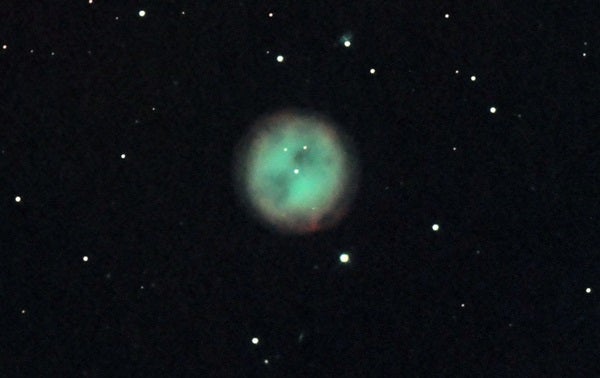Among the planetary nebulae in the high northern heavens, M97, the Owl Nebula, is the most famous. Pierre Méchain discovered it on Feb. 16, 1781, about 2.5° southeast of Merak (Beta [β] Ursae Majoris), noting it was difficult to see with crosshairs illuminated. Messier agreed, recording, “its light is faint.” The difficulty is not so much its brightness (magnitude 9.8), but that its dim light is spread across nearly 3.5′ of sky. Nevertheless, today the Owl is one of the most sought-after planetary nebulae in the sky, mainly because it presents observers with a challenge: literally seeing eye-to-eye!
The “owl” moniker comes from a sketch made in 1848 by William Parsons, Earl of Rosse, through his 72-inch Birr Leviathan reflector, which shows the round nebula’s curious eyelike hollows. With a star in each socket, these eyes seem to peer out from a face similar to that of a barn owl. Lord Rosse wrote that the stars were “considerably apart in the central region” and surrounded by a “dark penumbra.” Small-telescope users can infer the Owl’s eyes at moderate magnifications by sweeping their gaze back and forth across M97’s softly glowing circular disk, which shines with a pale gray pallor. Switch to high power (350x and greater) to search for the two dim stellar pupils.
Lying some 2,600 light-years distant, this planetary nebula sports a classical circular planetary shape with a complex structure consisting of three concentric shells: a faint outer halo, a circular middle shell, and a roughly elliptical inner shell. These shells were expelled from its dying Sun-like star beginning some 6,000 years ago. First, normal stellar winds created the outer shell after fusion in the parent star’s core ceased. Then the star began shedding its mass very quickly in a superwind, which drove even more gas and dust outward to form the middle shell. Finally, an even faster stellar wind compressed the superwind to form the inner shell and a bipolar cavity — a barrel-like component oriented at an angle 45° to the line of sight whose matter-poor tips create the Owl’s eyes. If you have trouble perceiving the eyes, try instead for the dim bar of light that separates them.
Make sure to explore Astronomy’s full list of 101 cosmic objects you must see. New entries will be added each week throughout 2022.
To get the latest astronomical news and observing content delivered directly to your door, subscribe to Astronomy magazine today!










